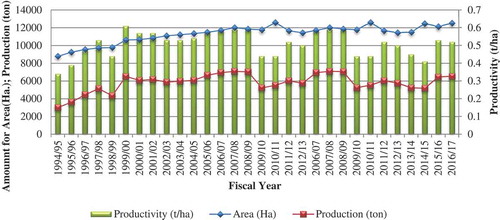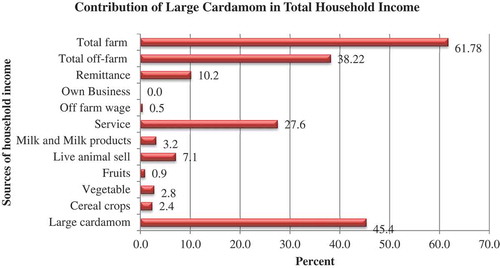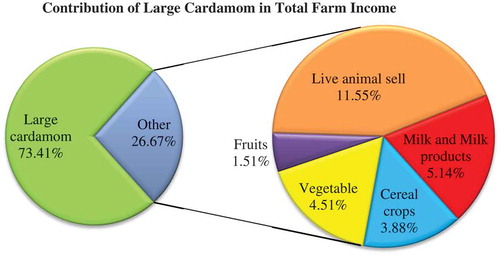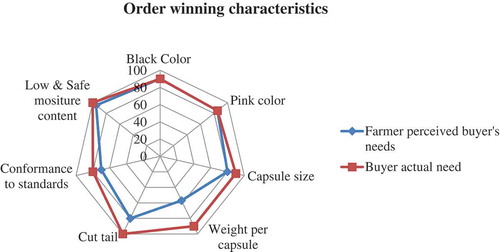 ?Mathematical formulae have been encoded as MathML and are displayed in this HTML version using MathJax in order to improve their display. Uncheck the box to turn MathJax off. This feature requires Javascript. Click on a formula to zoom.
?Mathematical formulae have been encoded as MathML and are displayed in this HTML version using MathJax in order to improve their display. Uncheck the box to turn MathJax off. This feature requires Javascript. Click on a formula to zoom.Abstract
Large cardamom is a high-value spice crop grown commonly in mid-hills of Nepal. Price disparity coupled with production challenges are major immersing concerns in growth and development of this sub-sector. The study was designed in January 2019 to assess production scenario and marketing of large cardamom in Bhojpur district of Nepal. Altogether, 120 large cardamom growers and 20 traders were selected using purposive sampling technique. Data were analysed using SPSS and Ms-Excel. Cobb-Douglas production function was used to estimate the factor share to the total output production. Findings revealed that more than 45% of total annual household income was attributed by cardamom itself. Overall benefit and cost ratio was found greater than unity (1.467). Cobb-Douglas production function showed that all cardamom-growing farmers were experiencing increasing returns to scale. Higher producer’s share (90.32%) was found when farmer sell their large cardamom directly to the exporter while least producer’s share (69.21%) was found in domestic market channel with large number of intermediaries. Increase in marketing margin, marketing costs and decrease in marketing efficiency and producers’ share were observed with increase in number of marketing intermediaries and vice-versa. About 55% of the large cardamom exporters believed that the Indian market was the most responsible factor for export price determination. From study, it is recommended to strengthen market or price intervention by concerned authority and also it is high time to identify possible routes to potential international markets (besides India) to receive competitive higher price.
PUBLIC INTEREST STATEMENT
Large cardamom is an indigenous spice crop grown commonly in the mid-hills of Nepal. It alone contributes 7% of the total agricultural export. More than 67,000 people are directly or indirectly related to this industry. Dried capsule of large cardamom are usually marketed. It is consumed mostly as spice however essential oils obtained from it through steam distillation were reported to have many medicinal usage. High value cash crop-large cardamom provides income and employment opportunity however the production challenges and problems associated with its market and market price is very crucial to study. Therefore, results from this research study will provide ground for the scientific reasoning of possible intervention and policy implication for growth and development of this sub-sector.
1. Introduction
Large Cardamom (Ammomum subulatum Roxburg), also known as ‘Black Cardamom’ or ‘Nepalese Cardamom’ or ‘Greater Indian cardamom’ or ‘Aalaichi’ is an indigenous to moist deciduous and ever green forests of sub Himalayan tracts (Peter & Shylaja, Citation2012; Rao, Kumar, Chatterjee, Naidu, & George, Citation1993). It is a high value spice crop that is grown most commonly in the mid-hill districts of eastern Nepal (Bhattarai, Nepali, Thaller, Thewarapperuma, & Webb, Citation2013). Large cardamom is perceived as ‘Black Gold’ (Black = colour of capsule Gold = indicate its high value). About 67,000 families are directly and indirectly involved in production of large cardamom (ITC, Citation2017). Agriculture Development Strategy 2015–2035 (ADS) has prioritised large cardamom as the commodity with comparative advantages in export markets. In Nepal, Large cardamom is one of the major export-oriented crops after lentil, which contributes about 7% in the export trade of agricultural commodity (ADS, Citation2014). About 90% of large cardamom produced in Nepal is exported to India through the port of Birtamod in Jhapa district (ITC, Citation2017). In the global market, Nepal is also recognised as the leading producer and exporter of large cardamom (MoAD, Citation2015). However, there is no consistency in production and export. Productivity of large cardamom in Nepal is 500 kg ha−1, which is far below to average yield (Yadav, Shrestha, & Mandal, Citation2015). Figure shows the area under large cardamom, national production and productivity.
At present, large cardamom is grown in 53 districts of Nepal (Kalauni, Citation2019). About 84% of the large cardamom harvest comes from the eastern region, including Ilam, Taplejung, Sankhuwasabha, Dhankuta, Bhojpur, Tehrathum, and Panchthar districts (Singh & Pothula, Citation2013). Ramsai, Dammersai, Jirmale, Saune, Bharlang, Golsai, Ramla, Chebese are commonly found variety of large cardamom in the country (MoAD, Citation2015). Among them, Dammersia is believed to be originated in the Bhojpur district of Nepal (Timilsina & Paudel, Citation2016).
Bhojpur district occupied 2.6% of the total area with 2.4% of the total national production of large cardamom (DADO, Citation2016/17). Large cardamom productivity of Bhojpur was 420 kg ha−1 in fiscal year 2014/15 while national productivity was 530 kg ha−1 (DADO, Citation2014/15). In fiscal year 2016/17, large cardamom production has increased to 192 Mt with productivity of 480 kg ha−1 (DADO, Citation2016/17). More details about the total productive area, production and yield for last 3 years are shown in Figure .
There exist many problems associated with this subsector of agriculture. Being an indigenous spice crop, grown by the people since ancient time; traditional cultivation and management practice are common. For instant, one most relevant example of traditional practice that very commonly exists among Nepalese large cardamom growers is no application of fertiliser in cardamom orchards, and relying only upon shaded leaves, weeds that decay and provides nutrient to plants. Disease and pest attack is also the major problem for the farmers (Bimali, Citation2014). The situation is more worsened due to feeble supply side and lack of easy availability of healthy seedlings in adequate amount. Due to short gestation period, most of the farmers practice rhizome separation method for transplantation, which has made orchards more prone to disease and pest infestation (Timilsina & Paudel, Citation2016). Due to comparative higher returns from the large cardamom, farmers are motivated and increase their efforts with expenses in terms of more labour, pesticides, etc. In the meantime, uncertain decline in price of large cardamom at the time marketing is becoming most disappointing factor for producer. Negative roles played by market agents to obtain lion’s share in marketing of large cardamom has further deteriorated the situation (MoAD, Citation2015).
In this context, large cardamom industry faces many challenges from production to marketing, which is disappointing entrepreneur from being involved in this sub-sector. Frequent price fluctuation and decreasing price trend from last few years are the major problems for farmers, collector, traders and other actors associated with value chain of large cardamom.
Therefore, this research study was designed with the broader objective as mentioned below:
Study of the production economics and marketing of the large cardamom in Bhojpur, Nepal
Specific objectives:
To study different aspects of large cardamom production, and its contribution to the annual household income
To identify existing market channels, producer’s share and marketing efficiency
To determine factors behind the export price determination for large cardamom
To estimate the critical success factor (CSF) in end market of large cardamom
2. Materials and methods
2.1. Study site
The study was carried out in Bhojpur district of Province No. 01. This mid-hill district lies in between 26°53ʹ to 27°46ʹ North latitudes and 86°53ʹ to 87°17ʹ East longitudes with an area 151,019 hectares (GoN, Citation2017). Temperature of the district ranges from 0.10°C (winter) to 32.2°C (summer) and the average annual rainfall ranges from 1005.9 mm to 2123.1 mm (DADO, Citation2014/15). District was selected as the study site since it had long history of growing large cardamom and also recognised as origin place of Dammersai cultivar (one and only one cultivar of large cardamom that is believed as originated in Nepal). The research was conducted in the command area of the Prime Minister Agriculture Modernization Project (PM-AMP), Project Implementation Unit (PIU), Cardamom Zone i.e. Arun rural Municipality (ward no. 02), Sadananda Municipality (ward no. 13 & 10), and Bhojpur Municipality (wards no. 04, 08, & 09). These municipalities were selected for the study because they are the major cardamom-growing domain within the district where farmers had vigorously expanded land under large cardamom cultivation.
2.2. Sample and sampling technique
A list of large cardamom-growing farmers from each research site was prepared separately, which was provided by Prime Minister Agriculture Modernization Project (PM-AMP), Project Implementation Unit (PIU), Cardamom zone, Bhojpur. A total of 120 respondents (large cardamom producer) were selected from Bhojpur district using purposive sampling technique (based on researcher’s experience and knowledge) to study production economics and marketing of large cardamom. Additionally, 6 local traders from Bhojpur district, 4 medium traders from Dhankuta district (Hile), 5 large traders and 5 exporters from Jhapa district were interviewed to know various details regarding marketing of large cardamom.
2.2.1. Research instruments/design
Data collection was done through personal interviews. Based on the interview schedule and checklist, questions were asked with the respondents to gain the aimed information. Key informant interviews (KIIs) were carried out with leader farmers, traders and other concerned stakeholders to assess additional information about large cardamom production and trade. Two focus group discussions (FGDs) were held with the people of similar interest for triangulation of obtained data through schedule interview. KII & FGDs were helpful for SWOT analysis (Table and Table ). Large cardamom producers were the major sources of primary data. Secondary information were collected from journal articles and departmental reports of Federation of Large Cardamom Entrepreneur Associations of Nepal (FLCEAN), International Centre for Integrated Mountain Development (ICIMOD), Ministry of Agriculture and Livestock Development (MoALD), Food and Agriculture Organization (FAO), Agribusiness Promotion and Marketing Development Directorate and Central Bureau of Statistics. Primary and secondary data were obtained and analysed.
2.3. Data analysis
Information collected from the field survey was coded and tabulated on Statistical Package for Social Science (SPSS) and Microsoft Excel. Analysis was done through SPSS, and MS- Excel. Descriptive statistics such as frequencies and percentage were calculated. Benefit cost analysis was estimated using the total cost of production of large cardamom and gross return from large cardamom production. The total cost of production was calculated by summing the variable cost and fixed cost items incurred in the production process.
Mathematical expression for B: C ratio:
For the analysis of gross margin, only the variable costs were considered. Gross margin was estimated as the difference between total value (return) of the large cardamom and variable cost involved in production:
Mathematical expression for gross margin:
Where,
Gross return (NPR) = Price of cardamom (NPR per kg) × Total quantity produced (Kg) and Total variable cost (NPR) = Summation of cost incurred in all the variable items (NPR)
Marketing cost, marketing margins, producer share and index of marketing efficiency were estimated as mentioned below:
Producer Share (PS) = {Producer price (Pf)/Retailer’s Price (Pr)} × 100
Where,
Ps = Producer’s share (%),
Pf = Producer’s price (NPR) and,
Pr = Retailer’s price (NPR)
Total Marketing Cost (MC) = Cost of (weighing+packing+loading) +Transportation tax + other associated tax
Total Marketing Margin (MM) = Retailer’s sale price-net price received by producer -marketing cost
Acharya’s Index of marketing efficiency = [Retailer’s price/(Marketing cost + Marketing margin)]—1 (Rane & Deorukhkar, Citation2007)
Cobb-Douglas production function was applied to estimate the factor share to the total output production.
Where, Y = total output (production), A = constant, L = Labour input, P = Pest management inputs, e = base of natural logarithm, u = random disturbance term, B1 and B2 are coefficient of respective variables.
CSF in end market was estimated as suggested by Kaplinsky and Morris (Citation2000).
3. Results and discussion
3.1. Production economics of large cardamom enterprise
3.1.1. Benefit cost analysis
Benefit and cost ratio (B/C) was used to analyse whether the large cardamom enterprise was profitable or not. Any enterprise with B/C ratio less than 1 are not viable since they are not rewarding or profit yielding. However, B/C ratio greater than 1 denotes viable enterprise that could be sustained. So, overall B/C was estimated in the study site, which was found greater than unity (1.467). This showed that the large cardamom enterprise was profitable in Bhojpur district. The details on benefit cost analysis of large cardamom in the study area presented in the Table .
3.1.2. Gross margin analysis
Estimation of the gross margin gave idea about the amount of the return that any enterprise gained after deducting operating (variable) cost which was found helpful to analyse whether the enterprise was providing enough returns to cover operating variable cost or not. So, gross margin was estimated by deducting the average variable cost occurring in large cardamom production from average gross return obtained from the selling of dried capsule. As presented in Table calculation showed that NPR 20,587.6 (USD 181.63) and NPR 88,489.2 (USD 780.67) were the gross margin per ropani (19.6 ropani = 1 hectare & 1 ropani = 0.051 hectare) and gross margin per 40 kilogram (kg).
3.1.3. Contribution of large cardamom to household income
The contribution of large cardamom in total annual household income was observed the highest (45.4%) in the study site followed by government service (27.6%), remittance (10.2%) and others as shown in Figure .
Further, it was clearly found that large cardamom was the major farm source contributing 73.41% to the total farm income as shown in Figure .
3.1.4. Cobb-douglas production function
The coefficients of all the quantitative variables have positive signs as shown in Table , which indicate the rational application of resources. The coefficients of labour and plant protection measures were found to be 13.368 and 2.322, respectively; and were significant at 5% level of significance. Between two different coefficients of input factors, the coefficient of labour was found to be the highest as compared to pest management. The reason behind this was that, most of expenditure incurred in large cardamom production was governed by labour. So, it became one of the most important factors determining the yield. Further, if the better labour management could be done for cultivation than yield may increase to a satisfactory level. Therefore, more labour was found to be used as compared to other factors. The sum of input elasticities of production functions was found to be 13.68. Thus, all cardamom growing farmers were experiencing increasing returns to scale.
3.2. Marketing of large cardamom
3.2.1. Marketing channels
Different marketing channels were observed in the study area. It was found that; mostly farmers sell cured capsule to the village-based collectors. Mostly young and experienced large cardamom growers were found engaged in village and district based collection of dried capsule. Following marketing channels were identified in the study area:
1. Farmers—Local trader—Medium trader—Large traders—Exporter
2. Farmers—Local traders—Large traders—Exporter
3. Farmers—Medium trader—Large trader—Exporter
4. Farmers—Medium traders—Exporter
5. Farmers—Exporter
6. Farmers—District trader—National retailers—Consumer
3.3. Marketing efficiency
Cardamom value chain analysis showed that the marketing efficiency and producer’s share on consumer rupees was decreasing with the increase in the number of the intermediaries as shown in Table . Producer share and index of marketing efficiency were found highest in marketing channel five where farmers directly sold their products to the exporters based in Birtamod. While the least producer share and index of marketing efficiencies were evident in marketing channel 6 (domestic market channel) where greater number of intermediaries were involved. Therefore, it denoted that decreasing intermediaries might be helpful in increasing marketing efficiency in this sub-sector or enterprise.
Table 1. Average cost and return per household in study areas
Table 2. Average gross margin of cardamom across the study sites
Table 3. Factors share to total output of cardamom in study area
Table 4. Estimates of marketing costs, margins, producer’s share and index of marketing efficiency
Table 5. SWOT analysis related to production
Table 6. SWOT Analysis related to market
3.3.1. Estimation of CSF in end market
Order qualifying characteristics meant those critical factor that producer need to achieve to participate in the market whereas order winning characteristics meant those important critical factors which lead particular firm to succeed, perhaps by selling at a price premium (Kaplinsky & Morris, Citation2000). It is though that to lessen the widespread price disparity among large cardamom growers, it is necessary to pay more attention toward the order winning characteristics. To know about the order wining characteristics, buyer’s actual need and farmer’s perceived need were estimated for different parameters as shown in Figure . Low and safe moisture content, cut tail, adequate weight per capsule, capsule size, black or pink colour of capsule were reported as the most important CSF in end market of large cardamom that might help farmers to receive the premium prices (or relatively higher prices compared to the price received by farmers at the time of study).
3.3.2. Factors affecting export price of large cardamom
Traders and Exporter based in Bhojpur and Jhapa (Birtamod) were asked about the various factors that affect the price of Nepalese large cardamom. Majority of the exporters (55%) respond that the demand of large cardamom in the Indian market is the major factor behind the determination of price. Where, 25% of traders and exporter reported that the quality of large cardamom was only the major factor influencing the price of the commodity. While some other 10% of respondent reported that production of the large cardamom in that very year was major factor responsible for the export price of the large cardamom. Competitors in international market (5%) and time of selling (5%) are least responsible for export price determination of large cardamom. From the interview, it was concluded that price of Nepalese cardamom mostly dependent on the demand from Indian market. In this context, identification of potential international markets other than India might help farmers to fetch higher price through direct export of Nepalese large cardamom to country like UK, Pakistan, U.A.E, America, etc.
3.4. Strength, weakness, opportunity and threat (SWOT) analysis
4. Conclusion
Higher gross margin and B/C revealed that the large cardamom enterprise is profitable and remunerative in Bhojpur district of Nepal. However, B/C for high value cash crop could be more than 2. From this, it can be inferred that there is need of further research to know the reasons behind inadequate benefit in this industry. Further, contribution of large cardamom in total household income is found significantly higher than any other sources. This clearly signifies the importance of high value large cardamom to the livelihood of mid-hill Bhojpur district of Nepal. So, it can be concluded that export potential crops like cardamom are important in uplifting the socio-economic status of the farmers in the rural part of Nepal. Thus, it is recommended to promote production of large cardamom through suitable subsidies and support in input materials, associated technical aspects, post-harvest processing and marketing activities. Also government is suggested to have proper and adequate market intervention by various means such as price determination, recognition of potential foreign market (other than India), and facilitation in direct export to third country.
COMPETING INTERESTS
Authors declare no competing interest.
Acknowledgements
We are highly delighted to acknowledge cardamom growers for their valuable information. Further, we also want to extend our deep respect and thankfulness to Associate Professor Shiv Chandra Dhakal, Assistant Prof. Rishi Ram Kattel, Assistant and Prof. Srurya Mani Dhungana for his consistent support and guidance in preparation of manuscript.
Additional information
Funding
Notes on contributors
Dharmendra Kalauni
Dharmendra Kalauni is an agriculture graduate from Agriculture and Forestry University, Nepal. Currently, he is working on research project ‘Characterisation and Evaluation of Nepalese Colocasia Landraces for Biodiversity Conservation’. His area of interest includes agricultural economics, food and nutritional security, and applied economics.
Arati Joshi
Arati Joshi is an agriculture graduate from Agriculture and Forestry University, Nepal. He is currently working as instructor of Agri-business and Agri-extension at Mahendranagar Higher Secondary School. Her area of interest includes agricultural extension and economics, horticultural crops, gender studies, and macroeconomics.
References
- ADS. (2014). Agriculture development strategy (2015–2035). Singhdurbar, Nepal: Ministry of Agriculture Development (MoAD), Government of Nepal.
- Bhattarai, S., Nepali, N., Thaller, J., Thewarapperuma, A., & Webb, J. (2013). Promoting agribusiness innovation in Nepal, feasibility assessment for an agribusiness innovation center. Washington, DC: Information for Development Program (infoDev)/The World Bank.
- Bimali, O. (2014). Alainchi Khetijo Bikas, Alainchi Smarika. Birtamode, Jhapa: Federation of Large Cardamom Entrepreneurs Association of Nepal (FLCEAN).
- DADO. (2014/15). Annual agriculture development program and statistics book. Bhojpur, Province-1, Nepal: Government of Nepal, Ministry of Agriculture Development, Department of Agriculture, Regional Agriculture Directorate, District Agriculture Development Office.
- DADO. (2016/17). Annual agriculture development program and statistic book. Bhojpur, Province-1, Nepal: Government of Nepal, Ministry of Agriculture Development, Department of Agriculture, Regional Agriculture Directorate, District Agriculture Development Office.
- GoN. (2017). District profile, Bhojpur-2074. . Province-1, Nepal: Government of Nepal, National Planning Commission, Central Bureau of Statistics, Statistic office, Bhojpur.
- ITC. (2017). Nepal national sector export strategy Large Cardamom 2017–2022. Geneva, Switzerland: Author.
- Kalauni, D. (2019, Feb. 24). The Spice of life. Retrieved from https://kathmandupost.com/opinion/2019/02/24/the-spice-of-life
- Kaplinsky, R., & Morris, M. (2000). A handbook for value chain research, 113. University of Sussex, Institute of Development Studies.
- MoAD. (2015). Trade flow analysis of Large Cardamom in Eastern Region. Singha Durbar, Kathmandu, Nepal: Government of Nepal, Ministry of Agricultural Development, Agribusiness Promotion and Statistics Division, International Trade Promotion Section.
- Peter, K., & Shylaja, M. (2012). Handbook of herbs and spices (second edition). (Vol. 1). USA: Woodhead Publishing Series in Food Science, Technology and Nutrition.
- Rane, A., & Deorukhkar, A. (2007). Economics of agriculture. New Delhi: Atlantic Publishers and Distributors (P) LTD.
- Rao, Y. S., Kumar, A., Chatterjee, S., Naidu, R., & George, C. K. (1993). Large cardamom (Amomum subulatum Roxb.)-a review. Journal of Spices & Aromatic Crops, 2(1 &2), 1–11.
- Singh, A. I., & Pothula, A. K. (2013). Postharvest processing of Large Cardamom in the Eastern Himalaya. Mountain Research and Development (MRD), 33(4), 453–462. doi:10.1659/MRD-JOURNAL-D-12-00069.1
- Timilsina, G. P., & Paudel, K. (2016). Improved Cardamom cultivation technology. Pakhribas, Dhankuta: Government of Nepal, National Agriculture Research Center(NARC), National Commercail Agriculture Program, Pakhribas, Dhankuta, Nepal.
- Yadav, P. K., Shrestha, K. P., & Mandal, D. L. (2015). Present situation and future strategies for research and development of Large Cardamom in Nepal. Proceedings of the Stakeholders Consultation Workshop on Large Cardamom Development in Nepal (pp. 1–8). Khumaltar: NARC.





